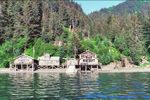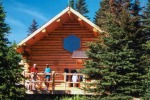KENAI NATIONAL WILDLIFE REFUGE
Alaska's Kenai Peninsula is, in geologic terms, still quite "young," since its entire land mass was covered by glacial ice as recently as 10,000 years ago. Much of that frozen blanket still exists today, in the form of the more than 800-square mile Harding Ice Field, which the refuge "shares" with Kenai Fjords National Park.
The grudging withdrawal of the Harding Ice Field has helped to make the lands of the Kenai National Wildlife Refuge a "miniature Alaska." Today, the refuge includes examples of every major Alaska habitat type. The refuge is an Alaska in miniature in its diversity of wildlife, as well. Sport fish bring hundreds of thousands of visitors to the peninsula each year. Eager anglers can pursue chinook, sockeye, coho and pink salmon; as well as northern pike, Dolly Varden char, rainbow trout, arctic grayling and steelhead. The refuge is also home to brown and black bears, caribou, Dall sheep, mountain goats, wolves, lynx, wolverines, eagles and thousands of shorebirds and waterfowl, not to mention the mighty Alaska-Yukon moose that the refuge was originally established (as the Kenai National Moose Range) to protect.
Today. The Kenai National Wildlife Refuge's wealth of habitat, scenery and wildlife draws a half a million visitors a year, more than any other wildlife refuge in Alaska.
The refuge often called "Alaska in miniature" is home to a wide variety of wildlife including moose, eagles, brown and black bears, lynx, wolves, and trumpeter swans.
The cultural history of the Kenai Peninsula spans 10,000 years; there are five distinct cultural traditions and both Indian and Eskimo occupations.
Day-UseFishingyes
Huntingyes
Hiking Trailyes



